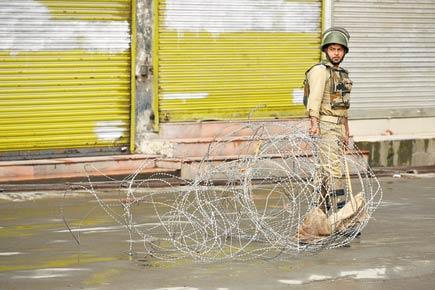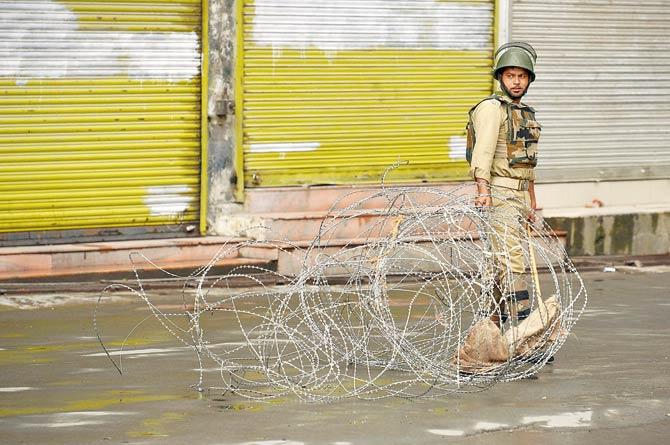As the 1984 Sikh massacre and the Bombay riots showed, clamping down on the media will only lead to the spread of malicious rumours

 The day Indira Gandhi was assassinated might be difficult for today’s generation to understand. It was 1984. No 24-hour news channels, no mobile phones, no internet and most people did not even have landlines. The flow of information was restricted and controlled — Doordarshan and Akashvani are run by the government — except for newspapers.
The day Indira Gandhi was assassinated might be difficult for today’s generation to understand. It was 1984. No 24-hour news channels, no mobile phones, no internet and most people did not even have landlines. The flow of information was restricted and controlled — Doordarshan and Akashvani are run by the government — except for newspapers.
 Kashmir remains in the grip of tight curfew and communication blockade following civilian deaths in the days after Burhan Wani’s killing. Pic/AFP
Kashmir remains in the grip of tight curfew and communication blockade following civilian deaths in the days after Burhan Wani’s killing. Pic/AFP
ADVERTISEMENT
And yet most people in India knew that something had happened. Rumours flew fast and furious across the country. Some found information from the BBC’s radio service. We knew that Sikhs were being attacked. We heard how Sikhs had celebrated her death. Without any news, it was hard to know what was fact and what was malicious fiction. As we know, thousands of innocent Sikhs were butchered, property was destroyed and wounds created which have not yet healed.
I am not certain that gagging the news actually helped anyone. Did this information blackout allow the goons to run amuck in Delhi? Did rumours of firecrackers going off and sweets distributed in celebration of Indira Gandhi’s death add to the murderous intent of Congress workers? If people had been informed that the actual perpetrators had been killed and that others were in custody would it perhaps have made a difference? Could the government and Rajiv Gandhi not have appealed for peace on TV and radio, asking people to stop this carnage?
A few years later, when the post-Babri Masjid demolition riots broke out in Mumbai, rumours ruled the day. The media was not gagged quite the way it has been in Kashmir now or had been in 1984, but access was similarly limited. And yet, we heard about how the water and milk supplies had been poisoned. People who went through Partition will remember similar rumours. When legitimate forms of information disbursal are limited or stopped, it is all too often misinformation which spreads with malicious glee.
In less dangerous but somewhat bizarre circumstances, can anyone remember how the ‘Ganesha drinks milk’ rumours spread across Mumbai and India in 1995? Then again, we did not have the sort of freedom of information we have now, and yet in a few hours people were running round to idols of the Lord Ganesha trying to get them to drink milk.
There was chaos on the streets of Mumbai for a few hours and milk was flowing through the gutters. Newspaper offices were inundated with calls. Few cared to believe that the milk-drinking had not really happened. And scientific explanations of ‘capillary action’ were pooh-poohed by the devout. By the afternoon, everyone from idols of Sai Baba to the Goddess Lakshmi was apparently drinking milk. The Siddhivinayak temple at Prabhadevi, Mumbai’s holiest shrine to the elephant-headed god, was one of the few which refused to give in to this mass hysteria. Milk sellers, of course, had a field day.
The next day it turned out that someone had got a phone call from a relative in England who had noticed this ‘phenomenon’. That it spread so fast across the country and to Indian communities across the world is a testament to the human ability to share what it knows and to believe it.
To gag the media, as has been done in Kashmir, is therefore counterproductive. The fear that facts will cause discontent ought not to be greater than the disturbing reality that lies create more problems.
In Gujarat in 2002, a few days into the riots, I came home at 1 in the morning, after a harrowing day at the newspaper office where
I worked. I found my building ablaze with lights and hundreds of people milling around the car park. I asked them what they were doing. They said they were up to protect themselves from a 15,000-strong marauding mob that was on its way to attack them.
By this time, the army was out on the streets and there was curfew. There were no marauding mobs anywhere. But so strong is the power of the rumour that it was difficult getting anyone to believe me.
We often belittle our democracy and the rights it gives us. But the need for a free, fair and fearless media is imperative and there is a reason for it.
To paraphrase Bob Dylan, the answers are blowing in the wind.
Ranjona Banerji is a senior journalist. You can follow her on twitter @ranjona
 Subscribe today by clicking the link and stay updated with the latest news!" Click here!
Subscribe today by clicking the link and stay updated with the latest news!" Click here!







